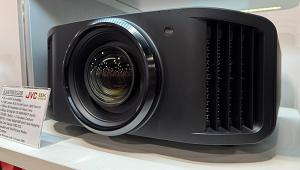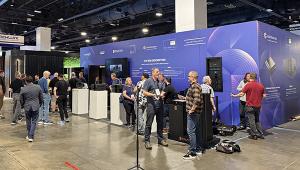The following link is to a Home Theater Mag HTIB system that received their top pick. I read the review, bought it for my In-Laws, and agree that its excellent performance makes it a best bang for the buck.http://hometheatermag.com/hometheaterinabox/1008panahtib/
HTIBs, Signal Switching, Balanced Cables

I am currently interested in purchasing a 5.1 home-theater-in-a-box system, and I'm reasonably aware of the available products. However, I am unable to determine which is the appropriate system for me. I had short-listed the Harman Kardon HKTS8/AVR-135 bundle (~$630) and the Sony DAV-DZ870 (~$550). I was going through Home Theater's reviews of the best HTIBs, and Onkyo HT-SR800 seems to be pretty good, though I haven't checked it out yet. I am now confused. What would you recommend?
Furqan Aziz
The Onkyo HT-SR800 ($600, replaced by the HT-SR5100 at the same price) is very good, though it does not include a DVD or Blu-ray player. We haven't reviewed the other systems you mention, so I can't comment on their performance. I've always really liked Onkyo's products because they offer excellent performance for the money. If you already have a disc player, I don't think you can go wrong with the Onkyo system. If you don't have a player, you're not bound by what the system provides—you can get whatever you want, either DVD or Blu-ray.
Which Switch?
I've got a 54" Mitsubishi DLP RPTV, PS3, and a PVR. Is there a big price difference between getting a system with HDMI pass-through and getting one without? I was considering an Onkyo 7.1 system, but then I thought, well, my TV has all the inputs I need, so if I just connected the audio output of my TV to the home-theater system, would I still get all the 7.1 and 5.1 data that I would get by going directly to the receiver? Would this depend on my TV? Right now I'm going HDMI to my TV, which has an optical out for audio.
George Todd
Virtually all A/V receivers at all price points have HDMI switching these days, so that's not an economic factor. Of more concern is using your TV as the main signal switcher, which isn't the best approach. By doing it the way you suggest, you'll miss the benefits of Dolby TrueHD and DTS-HD from Blu-ray discs that provide these new, advanced audio formats. You will hear multichannel audio in the form of regular Dolby Digital and DTS, but not the enhanced sound quality of the new, lossless formats.
The best approach is to use a good A/V receiver as the central signal switcher and connect its HDMI output to the TV with a single cable. I realize this seems to waste all those inputs on the TV, but an AVR is specifically designed to perform exactly this function. Also, you can connect your audio sources, such as a CD player, iPod, etc., to the AVR as well and select whatever you want to watch or listen to from the same device. If you connect the video sources to the TV and the audio sources to the AVR, it will be far more complicated to select what you want.
Balancing Act
There are some awesome AVRs out there, but I think it's a big compromise to run long speaker cables all around the room. Nearly every speaker manufacturer recommends using equal-length speaker cables. So unless you use monoblocks for each channel, you defy that logic.
I am currently looking at getting the Anthem D2 v2 pre/pro and using the Focal SM Twin6 Be active speakers. This eliminates the long runs of speaker cable and allows the use of balanced cables, which I believe are much better in that situation.
I guess the biggest disadvantages with active speakers are needing a nearby power outlet for each one and not being able to choose an amp that sounds a particular way. Also, there are very few active speakers on the market for domestic use. I wonder why more speaker companies don't make active speakers for home theater?
Bottom line—do you believe that long balanced-cable runs are better than long speaker-cable runs?
Darren Gum
Absolutely! You are entirely correct that long balanced cables are much better at rejecting interference and noise than long speaker cables. However, pre/pros with balanced outs are generally more expensive than many AVRs, and then you have to buy power amps or powered speakers, increasing the cost of the system even more. I agree that the best solution is a balanced-out pre/pro and a monoblock for each speaker (or powered speakers), but this is a very expensive approach that few can afford.
On the other hand, I've rarely had any real problems with AVRs and speaker cables. If the cable lengths are as short as possible, and the cables are routed carefully (avoiding proximity with AC power cables, for example), there shouldn't be a problem. Regarding cable lengths, I've always believed that speaker cables should be of equal length, but recent reader comments have caused me to reconsider this position. I now wonder if it's really a significant factor.
I have no idea why more consumer-speaker companies don't make active speakers. I've always been a big fan of this idea, which lets the manufacturer match the amps to the speakers. As you say, however, this prohibits the user from selecting amps that have the sound they want.
If you have a home-theater question, please send it to scott.wilkinson@sorc.com.
- Log in or register to post comments

One thing about HTiBs like that Panasonic is that if I have a Playstation, an X-Box, cable STB, or anything else, I can only connect one digitally(Optical) and one mono. That's one of the reasons I've never been a big fan of these types of HTiBs. If I were to get one, I'd probably go with one that doesn't have a DVD/Blu-Ray built in--there are always limited connections. Also, there is no way to upgrade this system. If you wanted to get bigger/better speakers, you'd have to buy a totally different reciever. You can't mix and match with these since by the specs it looks like the surround speakers are 3 ohm! Good luck trying to find a reciever to push those. Personally, I like the Onkyo's if I were to go with a HTiB.


























































